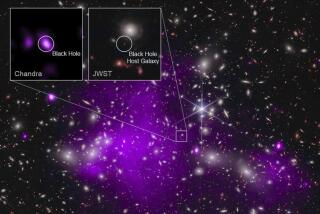Evidence of Colossal Black Hole Discovered : Astronomy: Object 30 million light-years away is believed to have the mass of a billion suns. The finding, based on calculations, moves theoretical concept closer to accepted reality.
- Share via
Evidence of a monstrous black hole with the mass of a billion suns, 100 times more powerful than any apparent black hole previously detected, is being announced by two astronomers in today’s issue of the Astrophysical Journal.
The discovery moves the black hole further along from theory to accepted reality. It also illuminates the nature of the mysterious, brilliant objects known as quasars, which once existed in plenitude throughout the universe.
Albert Einstein’s general theory of relativity postulates the existence of massively heavy, super-condensed black holes, exerting so much gravity that even light cannot travel fast enough to escape their pull. Such a hole would suck in stars, gas and whatever else was in range of its ferocious grasp.
If the black hole was massive enough, the trail of shining objects falling into it could be so luminous that it would fit the description of a quasar. But the suspected black hole at the center of a galaxy called NCG 3115 is the first with enough mass to have once created a quasar.
It provides “crucial confirmation” that quasars were the clusters of material feeding huge black holes, said one of its discoverers, Douglas O. Richstone of the University of Michigan.
For decades, no black holes were observed and some scientists voiced doubts that the objects exist. Because black holes are by nature invisible, the search was difficult.
But astronomers have found tantalizing hints of the violent activity that should accompany the immense pull of a black hole. In the last 10 years, several candidates were identified, most recently in data transmitted by the Hubble Space Telescope.
To make a black hole out of the Earth, the planet’s mass would have to be compressed to the size of a marble. Richstone and John Kormendy of the University of Hawaii believe that in NCG 3115, they have found a black hole about half the size of the solar system.
“If you replace the sun with this black hole,” Kormendy said in a telephone interview, “the Earth would be inside it, but the outermost planets wouldn’t.” He paused. “At least they wouldn’t right away.”
Over the course of three years, Kormendy was able to observe NCG 3115--about 30 million light-years away--for a total of about three hours using the Canada-France-Hawaii Telescope on the slope of Mauna Kea in Hawaii.
“These are very fine observations and they had extraordinarily good conditions in which to obtain them,” said Roger Blandford, a Caltech astronomer who specializes in black hole theory. “They’re terribly hard to make.”
The techniques used by Kormendy and Richstone to deduce the presence and size of the black hole also are extremely reliable, Blandford added.
“It’s a good strong case,” he said, “probably about the best we’ve got.”
Kormendy and Richstone “weighed” a section of the galaxy near the center by measuring the speed of orbiting stars. The faster the stars whirl around the center, the more force is being exerted upon them.
Then the pair calculated the stars’ mass by measuring their brightness.
They found that there was 10 times more gravitational pull, and therefore 10 times more mass, in the center of NCG 3115 than could be accounted for by the stars.
Some incredibly strong invisible force had to be present or the galaxy would have flown apart.
After considering and rejecting other explanations, the pair concluded the force could only be a “super-massive” black hole, Richstone said.
At one time, the stream of bright material fueling the black hole could have been brighter than the brightest galaxy, he added.
Apparently, however, the force has gobbled up all the stars and gas within reach.
Quasars have been found at the edges of the universe, which means they are being seen as they were billions of years ago. But they are not seen anywhere near this galaxy and are not as plentiful as they used to be.
So dormant, unimaginably forceful black holes should be common in our section of the universe, Richstone said.
Cosmic Discovery
What Is a Black Hole?: Albert Einstein’s general theory of relativity postulates the existence of black holes, which are massively heavy, supercondensed galactic centers. They exert such strong gravity that even light cannot travel fast enough to escape their pull.
What Is a Quasar?: Quasars are extremely luminous objects that appear in telescopes as starlike points that shine with the energy of an entire galaxy. They have been observed only at the very edges of the universe, which means their light has been traveling for billions of years. Theorists speculate that a trail of gas being sucked into an exceptionally massive black hole could account for the quasar’s luminosity.
The New Find: The suspected black hole at the center of NGC 3115, a galaxy 30 million light-years away, appears to be about half as large as our solar system while packing as much gravitational power as 1 billion suns.
Why It Is Significant: The black hole is the first detected that would have been powerful enough to attract enough material for a quasar. It is “crucial confirmation” of the nature of the mysterious bright lights.






